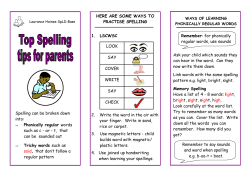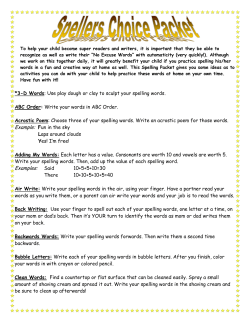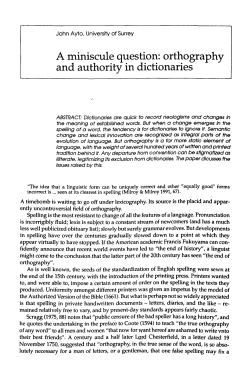
What is Word Study? Introduction
What is Word Study? Introduction The authors of the professional development book Words Their Way™: Word Study for Phonics, Vocabulary, and Spelling Instruction define word study as the integration of phonics, spelling, and vocabulary instruction. Word study teaches students how to look closely at words to discover the regularities and conventions of English orthography, or spelling. It takes the place of traditional spelling and vocabulary approaches, such as skill instruction, scope and sequence, or repeated practice. Purpose of Word Study The authors of Words Their Way: Word Study for Phonics, Vocabulary, and Spelling Instruction determined that the purpose of word study is twofold. First, students develop a general knowledge of English spelling. They learn how to examine words through active exploration using a hands-on, manipulative approach. Students also discover generalizations about spelling, instead of just spelling rules. They learn the regularities, patterns, and conventions of English orthography needed to read and spell. Second, word study increases students’ specific knowledge of words. Specific knowledge relates to the spelling and meaning of individual words. Basics of Word Study Word study evolved from over three decades of research that explored the developmental aspects of spelling. These researchers, including the authors of the text Words Their Way: Word Study for Phonics, Vocabulary, and Spelling Instruction, examined the three layers of English orthography—alphabet, pattern, and meaning. In their research, they found that each layer builds on a previous layer. The alphabet layer is based on the relationship between letters and sounds. For example, in the word cat, a single letter represents each sound. Students blend the sounds for /c/, /a/, and /t/ to read the word cat. In the word chip, students still hear three sounds even though there are four letters, because the first two function as one sound. These examples show how to create words by combining letters, either singly or in pairs, to form sounds from left to right. Copyright © 2009 Pearson Education, Inc. or its affiliates. All rights reserved. 1 The pattern layer overlies the alphabet layer because there’s not always a single sound for each letter. In the English language, single sounds are sometimes spelled with more than one letter or are affected by other letters. When students look beyond single letter and sound match-ups, they must search for patterns. For example, a final e will often make the preceding vowel stand for the long vowel sound, like in the word cape. It follows a pattern of consonant-vowel-consonant-silent e. The meaning layer focuses on groups of letters that represent meaning directly. Examples of these groups or letters include prefixes and suffixes. Here is a specific example of how meaning works in the spelling system. Take the prefix re–. Whether students pronounce it as ree like in rethink or ruh as in remove, its spelling stays the same because it directly represents meaning. Stages of Spelling Development When implementing word study in the classroom, it is important to understand the progression of the stages of spelling development. It will help teachers determine which word study activities are most appropriate for students. The methodology of the professional development book Words Their Way: Word Study for Phonics, Vocabulary, and Spelling Instruction is based on the progression of these developmental stages. The stages of spelling development are Emergent, Letter Name-Alphabetic Spelling, Within Word Pattern, Syllables and Affixes, and Derivational Relations. These stages describe students’ spelling behavior as they move from one level of word knowledge to the next. In Words Their Way: Word Study in Action, these stages have been adapted to correspond to specific levels (A through E), as well as to grade levels within the program. Each developmental spelling stage is examined in greater depth below. Copyright © 2009 Pearson Education, Inc. or its affiliates. All rights reserved. 2 Stage 1: In the Emergent Spelling stage, or Level K, students are not yet reading conventionally. In most cases, they have not been exposed to formal reading instruction. During this stage, children learn to recognize and write the letters of the alphabet. They play with the sounds in letters and words. Through most of Level K, students sort pictures by rhyme and beginning sound. By the end of the level, students understand the concept of words and begin to match picture cards to the words that represent their names. Stage 2: Students in the Letter-Name Alphabetic Spelling stage, or Level A, have been instructed formally in reading. At the beginning of this stage, students apply the alphabet principles to consonants. By the end of the stage, they are able to correctly represent most short-vowel patterns, consonant digraphs, and consonant blends. Stage 3: At the beginning of the Within Word Pattern Spelling stage, or Level B, students spell most single-syllable, short vowel words correctly. Throughout this stage, they move away from the soundby-sound approach of the letter name and begin to include patterns or chunks of letter sequences that relate to both sound and meaning. Stage 4: In Words Their Way: Word Study in Action, the Syllables and Affixes Spelling stage is divided into two stages. By the Syllables and Affixes Spelling stage, or Level C, students can spell most one-syllable, short and long vowel words correctly. So, the focus for instruction in this stage is multisyllabic words and patterns. Students also learn to sort by specific vowel combinations, inflected endings, and vowel patterns in accented syllables. In the Middle-Late and Affixes Spelling stage, or Level D, students begin with the study of how syllables divide in words with open syllables, such as cli/mate and re/act, and closed syllables like sup/ply and hun/dred. The level also includes a thorough study of patterns of unaccented syllables. It ends with the study of less common prefixes and suffixes such as fore– and –ness and two-syllable homophones like cellar and seller. Copyright © 2009 Pearson Education, Inc. or its affiliates. All rights reserved. 3 Stage 5: At the beginning of the Derivational Relations Spelling stage, or Level E, students spell most words correctly. In this stage, they learn how to sort words by pattern and meaning with an emphasis on meaning and related word parts. They will discover how spelling preserves meaning even when there are changes in sound. Students will also learn common prefixes and suffixes, examine the meaning of bases and roots, and learn about the classical origin of polysyllabic words. What is the synchrony of literacy development? Dr. Donald R. Bear, one of the authors of Words Their Way: Word Study for Phonics, Vocabulary, and Spelling Instruction, found in his research that when teachers conduct word study with students, they address the learning needs in all areas of literacy, because development in one area relates to development in other areas. This harmony in development is described as the synchrony of reading, writing, and spelling development. This chart above, found in the teachers’ professional development text, Words Their Way: Word Study for Phonics, Vocabulary, and Spelling Instruction, shows the relationship of the reading and writing stages as they relate to the stages of spelling development. There is a progression of the behaviors of the reading and writing stages and the spelling stages with the layers of orthography—Alphabet, Pattern, and Meaning. It is important to understand these relationships, because the activities in Words Their Way: Word Study in Action are organized and follow this model of literacy development. Copyright © 2009 Pearson Education, Inc. or its affiliates. All rights reserved. 4
© Copyright 2025





















